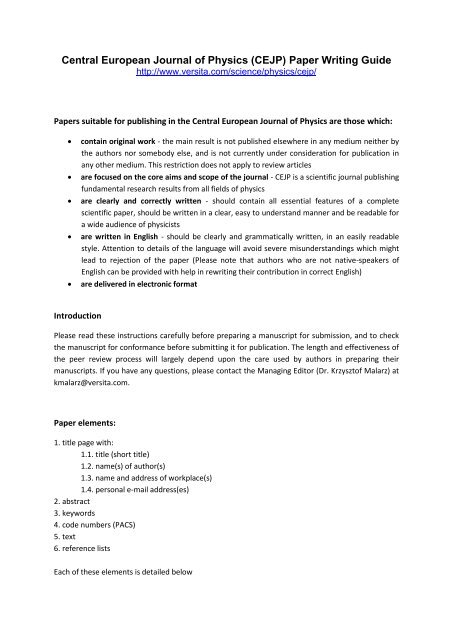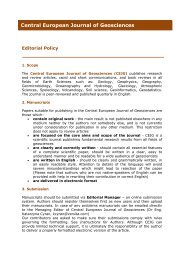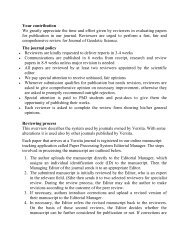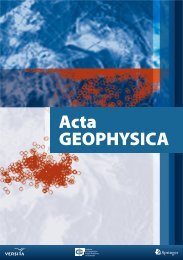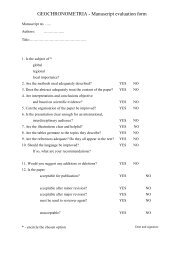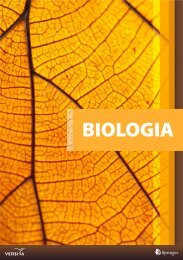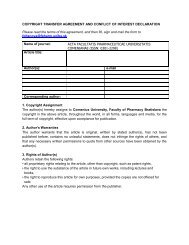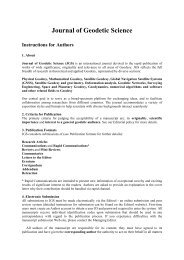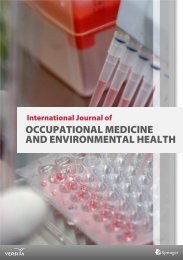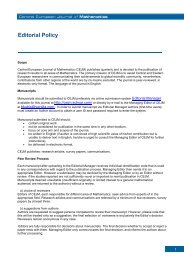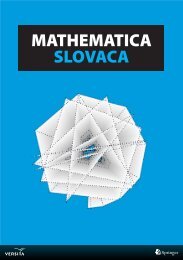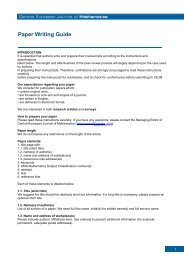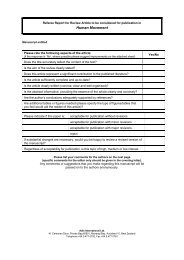(CEJP) Paper Writing Guide - Versita
(CEJP) Paper Writing Guide - Versita
(CEJP) Paper Writing Guide - Versita
Create successful ePaper yourself
Turn your PDF publications into a flip-book with our unique Google optimized e-Paper software.
Central European Journal of Physics (<strong>CEJP</strong>) <strong>Paper</strong> <strong>Writing</strong> <strong>Guide</strong><br />
http://www.versita.com/science/physics/cejp/<br />
<strong>Paper</strong>s suitable for publishing in the Central European Journal of Physics are those which:<br />
<br />
<br />
<br />
<br />
<br />
contain original work - the main result is not published elsewhere in any medium neither by<br />
the authors nor somebody else, and is not currently under consideration for publication in<br />
any other medium. This restriction does not apply to review articles<br />
are focused on the core aims and scope of the journal - <strong>CEJP</strong> is a scientific journal publishing<br />
fundamental research results from all fields of physics<br />
are clearly and correctly written - should contain all essential features of a complete<br />
scientific paper, should be written in a clear, easy to understand manner and be readable for<br />
a wide audience of physicists<br />
are written in English - should be clearly and grammatically written, in an easily readable<br />
style. Attention to details of the language will avoid severe misunderstandings which might<br />
lead to rejection of the paper (Please note that authors who are not native-speakers of<br />
English can be provided with help in rewriting their contribution in correct English)<br />
are delivered in electronic format<br />
Introduction<br />
Please read these instructions carefully before preparing a manuscript for submission, and to check<br />
the manuscript for conformance before submitting it for publication. The length and effectiveness of<br />
the peer review process will largely depend upon the care used by authors in preparing their<br />
manuscripts. If you have any questions, please contact the Managing Editor (Dr. Krzysztof Malarz) at<br />
kmalarz@versita.com.<br />
<strong>Paper</strong> elements:<br />
1. title page with:<br />
1.1. title (short title)<br />
1.2. name(s) of author(s)<br />
1.3. name and address of workplace(s)<br />
1.4. personal e-mail address(es)<br />
2. abstract<br />
3. keywords<br />
4. code numbers (PACS)<br />
5. text<br />
6. reference lists<br />
Each of these elements is detailed below
1.1. Title (short title)<br />
We suggest the title should be relatively short but informative. If a long title is necessary, please<br />
prepare an optional short title.<br />
1.2. Name(s) of author(s)<br />
A list of all authors of the paper should be prepared. We need full first name, initial(s) for middle<br />
name(s) and full last name.<br />
1.3. Name and address of workplace(s)<br />
Authors' affiliations should be indicated in this section. Either endnote or footnote (endnote<br />
recommended) can be used to present additional information (for example: permanent, adequate<br />
postal addresses).<br />
1.4. Personal e-mail address(es)<br />
At least one e-mail address is needed. It will be used as the corresponding author's email address in<br />
all contacts with the authors.<br />
2. Abstract<br />
An abstract must accompany every article. It should be a brief summary of the significant items of<br />
the main paper. An abstract should give concise information about the content of the core idea of<br />
your paper. It should be informative and not only present the general scope of the paper but also<br />
indicate the main results and conclusions. An abstract should not normally exceed 200 words. It<br />
should not contain literature citations or allusions to the tables or illustrations. All non-standard<br />
symbols and abbreviations should be defined.<br />
In combination with the title and key-words, the abstract is an indicator of the content of the paper.<br />
Authors should remember that online systems rely heavily on the content of titles and abstracts to<br />
identify articles in electronic bibliographic databases and search engines. They are therefore<br />
requested to take great care in preparing these elements.<br />
3. Keywords<br />
A list of keywords, proposed by authors, separated by commas or semicolons is required. Up to five<br />
keywords is suggested.<br />
4. Code numbers (PACS)<br />
A list of Physics and Astronomy Classification Scheme (PACS) numbers, separated by commas or<br />
semicolons is required. Up to five codes is suggested. Authors are fully responsible for correctness of<br />
chosen codes.<br />
5. Text<br />
General rules for writing:<br />
- use simple and declarative sentences, avoid long sentences, in which the meaning may be<br />
lost by complicated construction;<br />
- be concise, avoid idle words;
- make your argumentation complete; use commonly understood terms; define all nonstandard<br />
symbols and abbreviations when you introduce them;<br />
- explain all acronyms and abbreviations when they first appear in the text;<br />
- use all units consistently throughout the article;<br />
- be self-critical as you review your drafts.<br />
Structure of a paper<br />
Research papers and review articles should follow a strict structure. Generally a standard scientific<br />
paper is divided into:<br />
- introduction: you present the subject of your paper clearly, you indicate the scope of the<br />
subject, you present the goals of your paper and finally the organization of your paper;<br />
- main text: you present all important elements of your scientific message;<br />
- conclusion: you summarize your paper.<br />
Experimental part and/or calculations should be presented in sufficient details to enable reader to<br />
repeat the original work.<br />
Footnotes/Endnotes/Acknowledgements<br />
We encourage authors to restrict the use of footnotes. If necessary, please make endnotes rather<br />
than footnotes. Allowable footnotes/endnotes may include:<br />
the designation of the corresponding author of the paper;<br />
the current address of an author (if different from that shown in the affiliation);<br />
traditional footnote content.<br />
Information concerning research grant support should appear in a separate Acknowledgements<br />
section at the end of the paper, not in a footnote. Acknowledgements of the assistance of colleagues<br />
or similar notes of appreciation should also appear in an Acknowledgements section, not in<br />
footnotes.<br />
Tables<br />
Authors should use tables only to achieve concise presentation, or where the information cannot be<br />
given satisfactorily in other ways. Tables should be numbered consecutively using Arabic numerals<br />
and referred to in the text by number. Each table should have an explanatory caption which should<br />
be as concise as possible.<br />
Figures<br />
Authors may use line diagrams and photographs to illustrate theses from their text. The figures<br />
should be clear, easy to read and of good quality. Styles and fonts should match those in the main<br />
body of the article. All figures must be mentioned in the text in consecutive order and be numbered<br />
with Arabic numerals.<br />
Typesetting<br />
Type main text in roman (upright) font. The chemical symbols and compounds, units of measure,<br />
most multiletter operators and functions should are written in roman upright as well. The variables,<br />
constants, symbols for particles, most single-letter operators, axes and planes, channels, types (e.g.,
n, p), bands, geometric points, angles, lines, chemical prefixes, symmetry designations, transitions,<br />
critical points, color centers, quantum-state symbols in spectroscopy, and most single-letter<br />
abbreviations should be written in roman italic. Boldface roman type is reserved for indicating<br />
vectors and in some special cases matrices.<br />
Mathematical symbols<br />
The multiplication signs are reserved for a vector product (A×B) and simple dot product (A•B). The<br />
only exception are numbers expressed in scientific notation (9.7×10 3 MeV).<br />
The use of the following standard symbols is strongly recommended:<br />
∝ proportional to<br />
≈ approximately equal<br />
≡ equivalent to<br />
∼ asymptotically equal to, similar to<br />
→ tends to<br />
c* complex conjugate of c<br />
A † Hermitian conjugate of matrix A<br />
A T transpose of matrix A<br />
< ...> average<br />
Units<br />
Units and dimensions should be expressed according to the metric system and SI units. This system is<br />
based on: meter (m), second (s), kilogram (kg), ampere (A), kelvin (K), mole (mol), and candela (cd).<br />
Most units are spaced off from the number, e.g. 12 mV. The only exceptions are:<br />
1%, 1‰, 1ºC, 1º, 1', 1".<br />
Decimal multiples or submultiples of units are indicated by the use of prefixes<br />
µ = 10 -6 , m = 10 -3 , c = 10 -2 , d = 10 -1 ,<br />
da = 10 1 , h = 10 2 , k = 10 3 , M = 10 6 , G = 10 9 , etc.<br />
Compound units are written as<br />
4221.9 J kg -1 K -1 or 4221.9 J/(kg K),<br />
with a thin space between unit parts.<br />
Please NOTE:<br />
Authors should indicate precisely in the main text where tables and figures should be inserted, if<br />
these elements are given at the end in the original version of the manuscript (or supplied in separate<br />
files).<br />
If this information is not provided along with the manuscript, we will assume that the figures and/or<br />
tables should be insert at the closest position to first reference to them in the published paper.<br />
Multimedia and images<br />
Authors can attach files in most popular formats, including (for example):<br />
- images in BMP, GIF, JPEG formats,<br />
- multimedia files in MPEG or AVI formats. However please keep to file types that are read by<br />
standard media players (e.g. RealPlayer, Quicktime, Windows Media Player) and/or standard<br />
office applications (Adobe Acrobat Reader, Microsoft Office etc.).
Your attachments may be accessible through links to external locations or to our internal locations (if<br />
you choose the second option, please remember to send us your attachments).<br />
Please remember that your images, video and animation clips are intended for internet use and we<br />
need to consider the needs of users with slow internet connections. Please try to minimize file sizes<br />
by using a lower resolution or number of colours for images and animations (as long as the material<br />
is still clear). To help you in formatting your images (including tables and figures) or multimedia files,<br />
please submit your paper with separate attachments, which are used in your paper.<br />
English language<br />
Central European Journal of Physics is published only in English. Make sure that your manuscripts are<br />
clearly and grammatically written. Please note that authors who are not native-speakers of English<br />
can be provided with help in rewriting their contribution in correct English. Try to prepare your<br />
manuscript in an easily readable style; this will help avoid severe misunderstandings which might<br />
lead to rejection of the paper.<br />
6. Reference list<br />
A complete reference should give the reader enough information to find the relevant article. All<br />
authors (unless there are six or more) should be named in the citation. If there are six or more, list<br />
the name of the first one followed by “et al.”. Please pay particular attention to spelling,<br />
capitalization and punctuation here. Completeness of references is the responsibility of the authors.<br />
A complete reference should comprise the following:<br />
6.1. Reference to an article in a journal<br />
Elements to cite:<br />
Author's Initials. Surname, – if more authors, see examples below<br />
Title of journal – abbreviated according to the ISI standards<br />
(see http://library.caltech.edu/reference/abbreviations/)<br />
volume number, page or article number (year of publication)<br />
Please supply DOI or URL for e-version of the papers.<br />
[1] A.P. Raposo, H.J. Weber, D.E. Alvarez-Castillo, M. Kirchbach, Cent. Eur. J. Phys. 5, 253 (2007)<br />
[2] J. Barth et al. (SAPHIR Collaboration), Phys. Lett. B 572, 127 (2003)<br />
[3] S. Chekanov et al., Eur. Phys. J. C 51, 289 (2007)<br />
[4] K. Malarz, Postepy Fizyki 57, 235 (2006) (in Polish)<br />
[5] G. Meng, Cent. Eur. J. Phys., DOI:10.2478/s11534-007-0038-1<br />
[6] R. Hegselmann, U. Krause, Journal of Artificial Societies and Social Simulation (2006),<br />
http://jasss.soc.surrey.ac.uk/9/3/10.html<br />
[7] A. Dybala, Cent. Eur. J. Chem. (in press)<br />
[8] A. Dybala, Przeglad chemiczny (in Polish, in press)
6.2. Reference to a book<br />
Elements to cite:<br />
Author's Initials. Surname,<br />
Title,<br />
Edition – if not the first<br />
(Publisher, Place of publication, Year of publication)<br />
[1] M. Lister, Fundamentals of Operating Systems, 3rd edition (Springer-Verlag, New York, 1984)<br />
6.3. Reference to a part/chapter book<br />
Elements to cite:<br />
Author's Initials. Surname,<br />
In: Editor’s Initials. Editor’s Surname (Ed.),<br />
Book Title,<br />
Edition – if not the first,<br />
(Publisher, Place of publication, Year of publication)<br />
page number<br />
[1] C.K. Clenshaw, K. Lord, In: B.K. P. Scaife (Ed.), Studies in Numerical Analysis (Academic Press,<br />
London and New York, 1974) 95<br />
6.4. Reference to a preprint<br />
Elements to cite:<br />
Author's Initials. Surname,<br />
arXiv:preprint-number and version<br />
[1] M. Majewski, K. Malarz, arXiv:cond-mat/0609635v2<br />
[2] J.A.C.E. Solano, arXiv:0707.1343v1<br />
6.5. Reference to a conference proceedings<br />
Elements to cite:<br />
Author's Initials. Surname,<br />
In: Editor’s Initials. Editor’s Surname (Ed.),<br />
Conference,<br />
date, place (town and country) of conference<br />
(Publisher, place of publication, year of publication)<br />
page number<br />
[1] A. Kaczanowski, K. Malarz, K. Kulakowski, In: T.E. Simos (Ed.), International Conference of<br />
Computational Methods in Science and Engineering, 12-16 Sep. 2003, Kastoria, Greece (World<br />
Scientific, Singapore 2003) 258
6.6. Reference to a thesis<br />
Elements to cite:<br />
Author's Initials. Surname,<br />
DSc/PhD/MSc/BSc thesis,<br />
University,<br />
(town, country, year of publication)<br />
[1] A.J. Agutter, PhD thesis, Edinburgh University (Edinburgh, UK, 1995)<br />
6.7. Reference to an article in a newspaper<br />
Elements to cite:<br />
Author's Initials. Surname,<br />
Newspaper Title,<br />
date of publication,<br />
page number<br />
[1] A. Sherwin, The Times, 13 Jul. 2007, 1<br />
[2] M. Dzierzanowski, Wprost, 8 Jul. 2007, 18 (in Polish)<br />
6.8. Reference to a patent<br />
Elements to cite:<br />
Originator,<br />
Series designation which may include full date.<br />
[1] Philip Morris Inc., European patent application 0021165 A1, 1981.01.07<br />
6.9. Reference to a standard<br />
Elements to cite:<br />
Standard symbol and number,<br />
Title.<br />
[1] ISO 2108:1992, Information and documentation – International standard book numbering (ISBN)<br />
[2] ISO/TR 9544:1988, Information processing – Computer-assisted publishing – Vocabulary<br />
Please add language of publication for materials which are not written in English. Indicate materials<br />
accepting for publications by adding “(in press)”. Please avoid references to unpublished materials,<br />
private communication and web pages.<br />
You should make sure the information is correct so that the linking reference service may link<br />
abstracts electronically. For the same reason please separate each reference from the others.
Before submitting your article, please ensure you have checked your paper for any relevant<br />
references you may have missed.<br />
Submission formats<br />
Manuscripts for <strong>CEJP</strong> can be submitted in the following formats:<br />
- TeX, LaTeX, AMSTeX, AMSLaTeX<br />
- MS Word (97 or higher) either as standard DOCUMENT (.doc) or RICH TEXT FORMAT (.rtf)<br />
- TXT<br />
- HTML<br />
The author may supply (additionally) a PDF, PS, or DVI file. It will be helpful for the review process of<br />
the paper.<br />
Supplementary data<br />
Authors can also submit any data files and additional figures in attachments. These elements can be<br />
submitted in any of the usual formats (PDF, MS Word, TeX, GIF, TIFF, etc.). It is possible that we may<br />
not be able to open your data files. To prevent any misunderstandings we request that authors<br />
submit a text file (instruction.txt) containing brief instructions on how to use the attached files.


